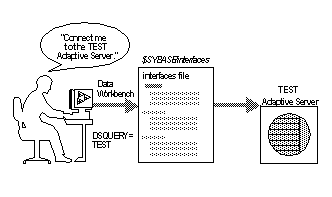Adaptive Server communicates with other Adaptive Servers, Open Server™ applications (such as Backup Server), and client software on your network. Clients can talk to one or more servers, and servers can communicate with other servers by remote procedure calls.
For Sybase products to interact with one another, each product needs to know where the others reside on the network. Names and addresses of every known server are listed in a directory services file. This information can be stored in a directory services file two different ways:
In an interfaces file, named interfaces on UNIX platforms, located in the $SYBASE installation directory, or
In an LDAP server
After your Adaptive Server or client software is installed, it can connect with any server on the network that is listed in the directory services.
When you are using a client program, and you want to connect with a particular server, the client program looks up the server name in the directory services and connects to that server, as shown in Figure 1-1. You can supply the name of the server by using the DSQUERY environment variable.
On TCP/IP networks, the port number gives clients a way to identify the Adaptive Server to which they want to connect. It also tells Adaptive Server where to listen for incoming connection attempts from clients. Adaptive Server uses a single port for these two services (referred to as query service and listener service).
On SPX networks, the socket number gives clients and servers a way to identify each other.
Figure 1-1: Communicating with a server using the interfaces file

During installation, you use the srvbuild utility to create a new server. The srvbuild process adds entries to the interfaces file for your new Adaptive Server, Backup Server, Monitor Server, and XP Server.
For instructions on using dsedit or dscp to modify existing interfaces file entries or to create new interfaces file entries for existing servers, see Chapter 3, “Configuring the Operating System for Adaptive Server.”